Art Nouveau, iridescent ceramics by Dominique ZUMBO (1854-1939), Manufacture Les Arènes de Fréjus factory (Var, Southern France))
Extremely rare statuary group in ceramic with iridescent enamel, signature under enemal " Dominique ZUMBO, Arènes Fréjus Var " and hollow workshop stamp, not very legible " Dominique ZUMBO ... artistic... "
1891-1917 period
Female nude languished on oval terrace. The nymph or amazon wears only a jewel, an arm double bracelet; her long, wavy free hair, as well as her charming feminine forms, resonate as a reminder of Art Nouveau and its aesthetic curves. The total freedom model's impression could also symbolize Women's liberation, an early 20th century new and strong social trend.
The artist often used female nude thema but for vase or pitcher ornamentation (please check last photo for other Zumbo ceramics pieces). To my knowledge , this is the only true pure statuary known subject of the artist. Zumbo' s ceramics' artistic production, recognized as having exceeded in quality that of Clément MASSIER in Vallauris will remain of small quantity compared to the creations of his master trainer.
He will also obtain an international reputation in front of it by winning Gold Medal at the prestigious Universal Exhibition in Paris in 1900.
"Dominique ZUMBO has Calabrian origin and arrived in France when he was 25's years old, in 1879, as a worker-potter of Massier (Jérôme, Clément, Delphin and Cédric), a dynasty of ceramists who played a main role in Vallauris ceramics revival.
Between 1879 and 1891, Zumbo worked with Clément Massier to perfect metallic reflections' technics. Dominique Zumbo is already frequently quoted about Massiers story, and we can find several mentions for awards obtained by the 2 ceramists at the universal exhibitions, between 1880 and 1900.
" Clément worked hard for his research, remarkably assisted by Dominique Zumbo. This last one know very wall enamels and metal oxides. Together, they will do many tests, and... Very few discoveries! However, their enthusiasm does not waver. In 1881, Clément obtained a diploma of honor at the Exhibition of Tours.
... in 1883, Clément Massier won gold medal at the Amsterdam International Exhibition
... in 1884, he participated in 8th exhibition of the Central Union of Decorative Arts (UCAD) in Paris on stone work, wood, earth, glass after obtaining a diploma of honor at international exhibition of Nice
... in 1886, he participated in National Industrial and Fine Arts Exhibition in Marseille and presented, then, his first successful metallic reflections! Dominique Zumbo is the indisputable accomplice of this victory. Together, they managed to subtly mix oxides and varnishes to separate the color of background from that of decorations; they gradually added to their initial formulas metals and other valuable components to acquire the desired colors; They obtained very precise contour decorations, without burrs, after having traced them with a stylus, they managed to control fire time and oxugen reduction, which are essential to iridescence success.
In January 1892, Zumbo has décides to settle in Frejus and create his own workshop in a district near the Arena.
In 1894, after obtaining a grant of 50 francs by the municipal council of Fréjus, he participated in the exhibition of Lyon.
"Shortly after this exhibition of 1894, and to preserve his discoveries, he recorded an exclusive patent of invention on July 6, 1897, registered under the number 265.417, for which "the Minister of Trade and Industry signs a patent without guarantee of the government". Zumbo himself describes the innovation: "The discovery consists in application and fixation of any drawings with metallic reflections on artistic pottery of any terracotta shape and size." In fact, Zumbo discovers that the success of its metallic reflections depends on "the maximum reduction of oxygen during cooking by transforming the copper (which then turns red) into an extremely thin layer of pure metal."We know that Zumbo prepared its pigments by dissolving copper in large quantities of vinegar.
All known works of Zumbo are now signed, either with his initials DZA (Dominique Zumbo Arènes), or with his full name and " Arènes de Fréjus " mention.
In 1897, at Nice International Food Competition, the jury awarded him the Grand Prix. Encouraged, "he participated in National Society of Fine Arts Exhibition (SENA), in 1897-1898"; In 1898, at Universal Exhibition in Turin, "a gold medal and a silver medal" were awarded to him; the same year, in London, he won the Grand Prix and his efforts were rewarded by the title of "Chevalier des Palmes académiques" for services rendered to the dissemination of art".
... In L'Éveil social newspaper of February 15, 1900, the journalist A. Audier wrote: "We learn with the greatest pleasure that, at the request of our friendly deputy, Maurice Allard, the Minister of Civic Education and Fine Arts, has just conferred the Academic Palms on Mr. Dominique Zumbo, the ceramic artist well known in our region ...While researching the ancient paintings and varnishes that decorate the ceramic objects of Roman period, from museum, he discovered the preparation of an enamel with splendid metallic reflections whose application made him obtain, at all his exhibitions , the highest awards (more than 20 gold medals) and was classified out of competition.
Despite his undeniable talent and his innovative advances to improve ceramics' techniques of irization, "his business failed. He went bankrupt in 1917 and lost his workshop "La Manufacture des Arènes". He then moved to Hyères with his eldest daughter. From 1917 to 1930, he continued his production alone, before retiring with his second wife to La Farlède (Var), where he died in 1939, when he was 85 years old.
His works are signed for the first period " Dominique Zumbo, Arènes de Fréjus-Var ", like here, and for the second period "Dominique Zumbo-Hyères-Var".
They are searched because its production is much lower than the production from the Massier workshops. They are found mainly in France, the United States and Germany. Dominique Zumbo had alot of descendants with his first wife, who died in 1918, but none of his children continued his work. The secret of his particular technique of metallic reflections, from local vinegar, died with him.
A room is specially dedicated to him at the Local History Museum of Fréjus, with some pieces of the artist (please check last photo).
Bibilography:
*https:/www.guichetdusavoir.org:question/voir/51167
*www.passionprovence.org/archives/2017/04/14/35014068.html
* "Barbotines De La Côte D'azur - Barbotine, Reflets Métalliques, Garnissage" par Maryse BOTTERO, édition Charles MASSIN, 2002
Dimensions: 28 length* 14 width * 18cm height
Condition: 2 tiny swings of enamel on the woman's fingertips restaured hand stretched upwards
Exceptional and stunning quality of enamelling with many and varied metallic reflections, from copper red, iridescent green and gold. Please check photos



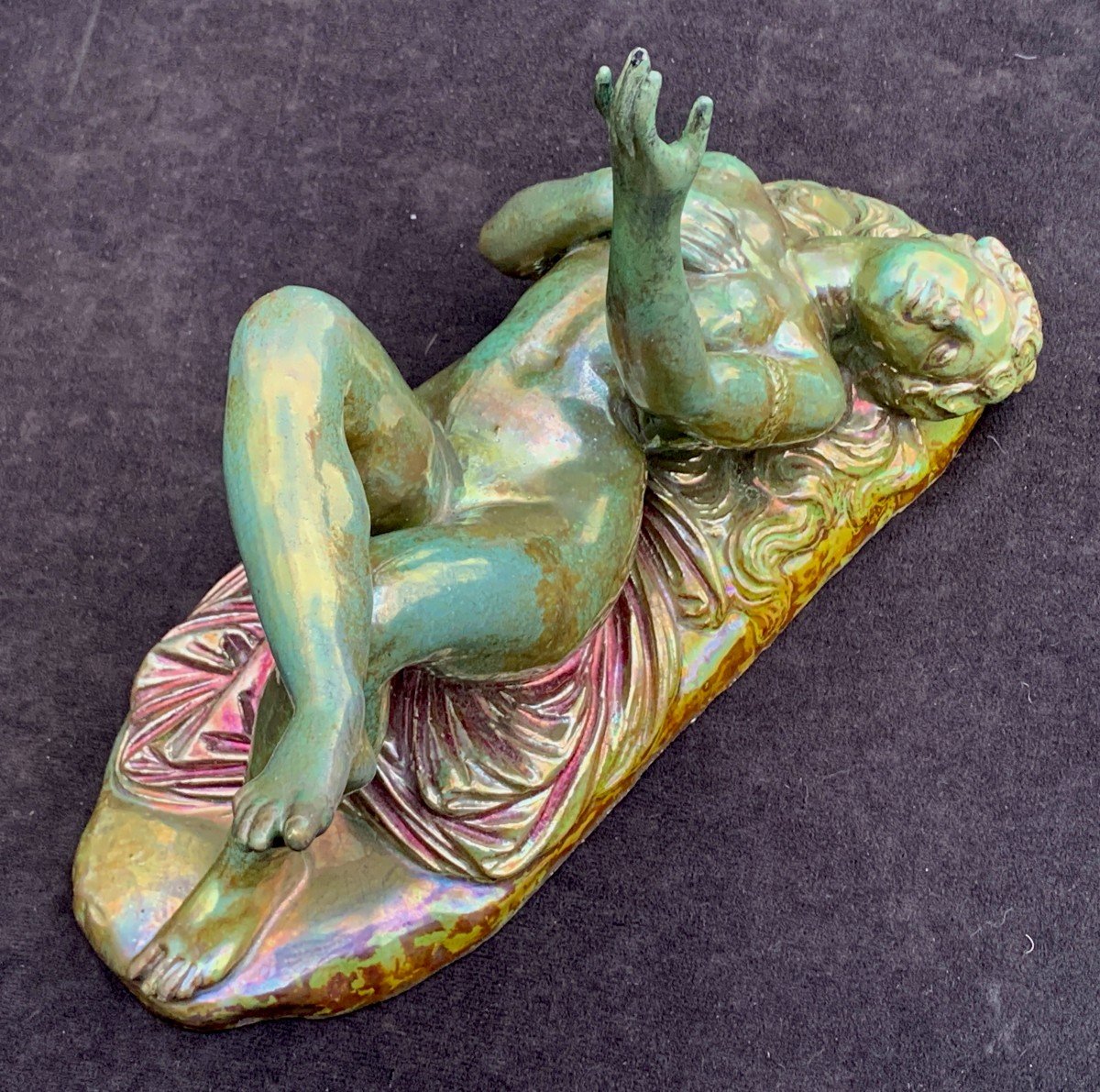




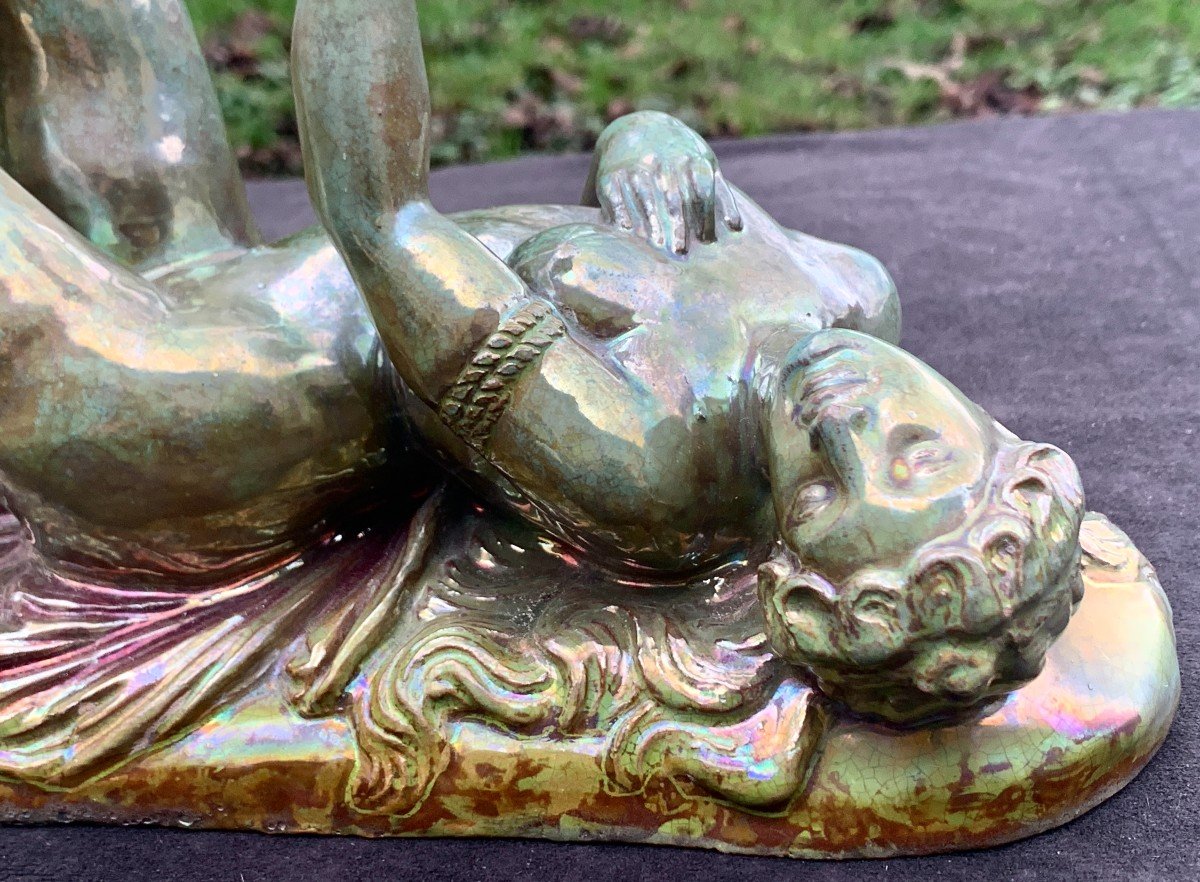

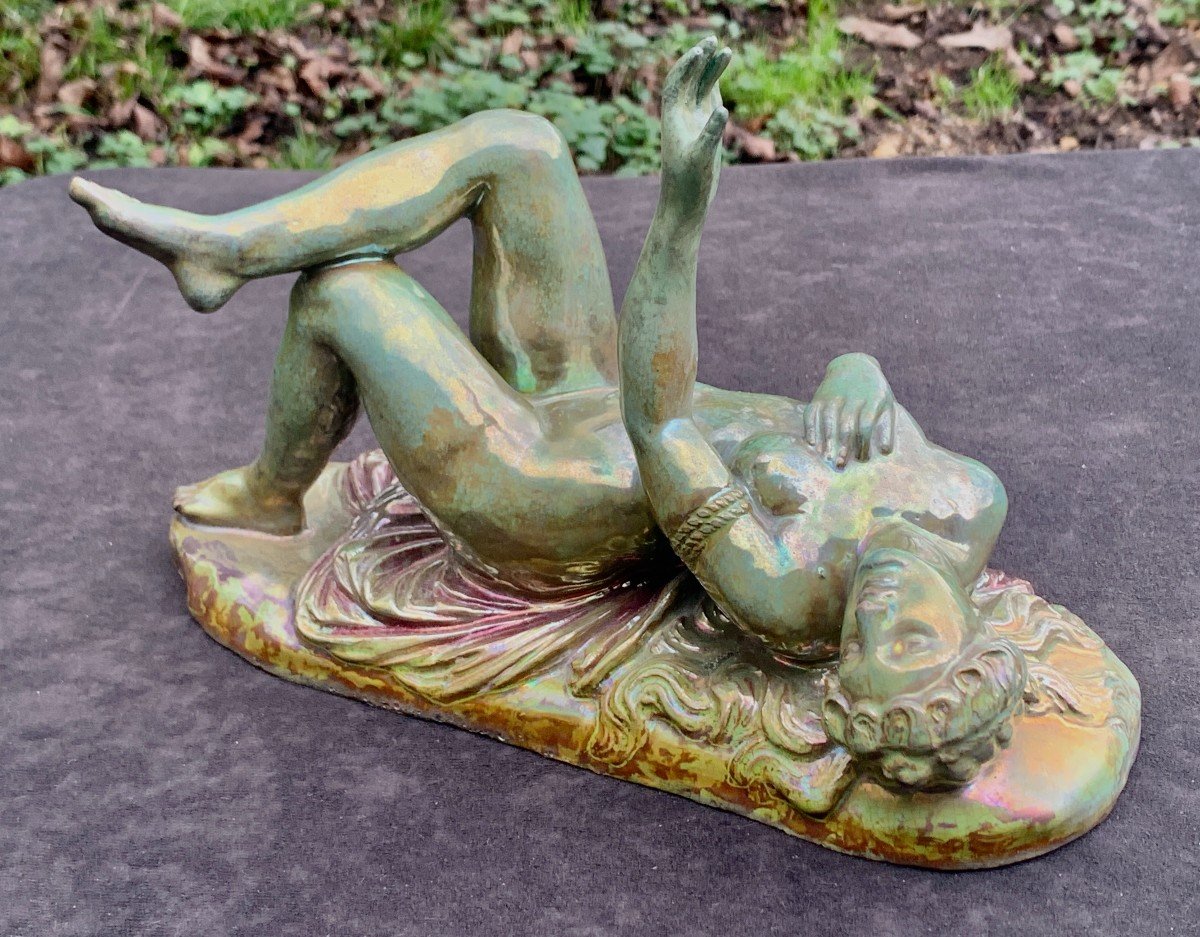




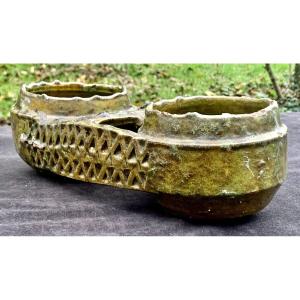


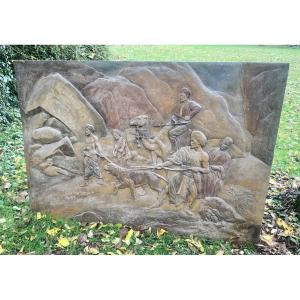
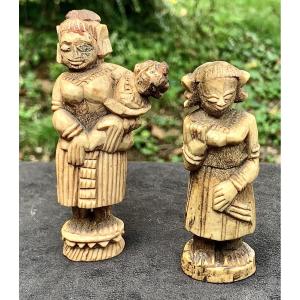


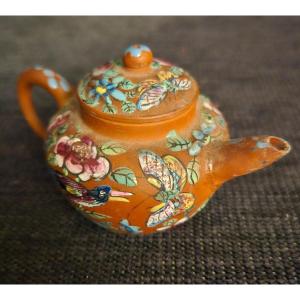






 Le Magazine de PROANTIC
Le Magazine de PROANTIC TRÉSORS Magazine
TRÉSORS Magazine Rivista Artiquariato
Rivista Artiquariato
